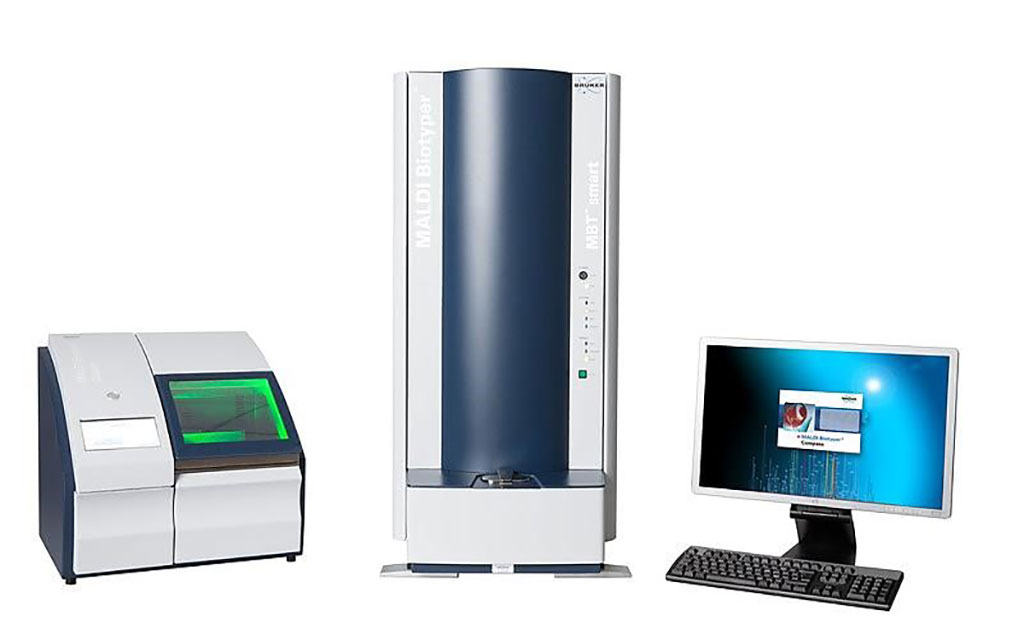MALDI-TOF Can Predict Antimicrobial Resistance in Clinical Samples
By LabMedica International staff writers
Posted on 27 Jan 2022
Antimicrobial-resistant bacteria and fungi pose a serious and increasing threat to the achievements of modern medicine. Infections with antimicrobial-resistant pathogens are associated with substantial morbidity, mortality and healthcare costs.Posted on 27 Jan 2022
Matrix-assisted laser desorption/ionization–time of flight (MALDI-TOF) mass spectrometry enables rapid microbial species identification. In only a few minutes, MALDI-TOF mass spectrometry can be used to characterize the protein composition of single bacterial or fungal colonies, and the results are available usually within 24 hours after sample collection.

Image: The Microflex Biotyper MALDI-TOF Mass Spectrometry System for fast, accurate and cost-effective microbial identification (Photo courtesy of Bruker Daltonics)
Medical Microbiologists at the University of Basel (Basel, Switzerland) and their colleagues developed a database, which they dubbed the Database of Resistance Information on Antimicrobials and MALDI-TOF Mass Spectra, or DRIAMS, by collecting MALDI-TOF mass spectra and resistance information on more than 30,000 clinical isolates from four different Swiss clinical labs.
The largest collection within DRIAMS, called DRIAMS-A, came from University Hospital Basel (Basel, Switzerland) and included 145,341 mass spectra. Most of the spectra could be generated from clinical samples within 24 hours. All laboratories used the Microflex Biotyper System (Bruker Daltonics, Bremen, Germany), which is a widely used MALDI-TOF mass spectrometry system. Resistance categories for bacteria were determined using either microdilution assays (VITEK 2, BioMérieux, Marcy l'Etoile France), minimum inhibitory concentration (MIC) stripe tests (Liofilchem, Roseto degli Abruzzi, Italy) or disc diffusion tests (Thermo Fisher Scientific, Waltham MA, USA). Resistance categories for yeast were determined using Thermo Fisher Scientific’s Sensititre Yeast One.
The investigators particular focused their analyses on three key clinical pathogens, Staphylococcus aureus, Escherichia coli, and Klebsiella pneumoniae, and antibiotics used to treat infections they cause. For all three, they reported a high overall performance. The classifier could predict S. aureus resistance to oxacillin with 80% accuracy as well as E. coli and K. pneumoniae resistance to ceftriaxone currently with 74% accuracy for both. For 31 of the 42 antibiotics studied, the classifier generated could correctly classify resistance with 80% accuracy. In a retrospective clinical case study, the researchers reviewed 416 cases with positive S. aureus, E. coli, and K. pneumoniae cultures. For 63 of these, an infectious disease specialist was consulted to help guide antibiotic treatment.
The authors concluded that their retrospective clinical case study shows that their classifier might have a beneficial impact on patient treatment and promote antibiotic stewardship. MALDI-TOF mass spectra-based machine learning may thus be an important new tool for treatment optimization. The study was published on January 10, 2022 in the journal Nature Medicine.
Related Links:
University of Basel
University Hospital Basel
Bruker Daltonics
BioMérieux
Liofilchem
Thermo Fisher Scientific







 assay.jpg)





